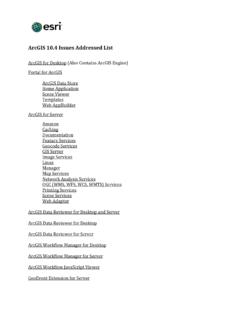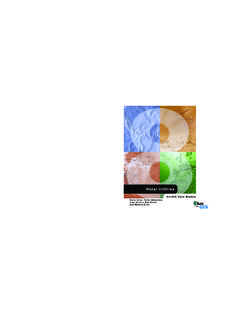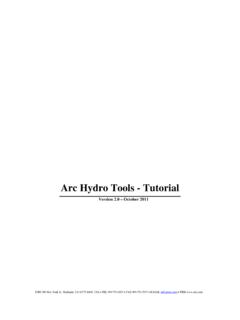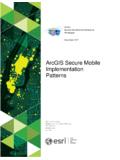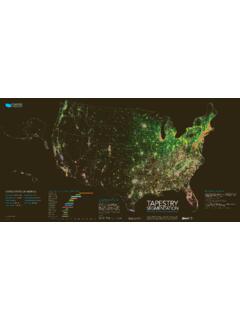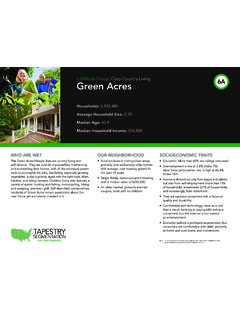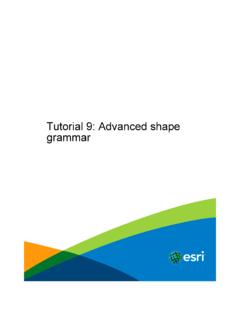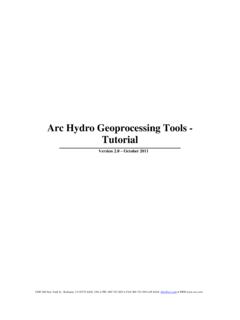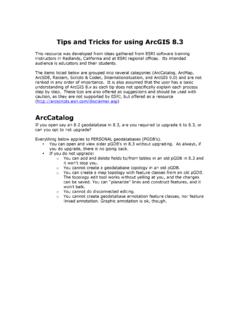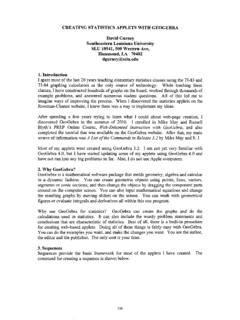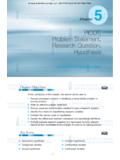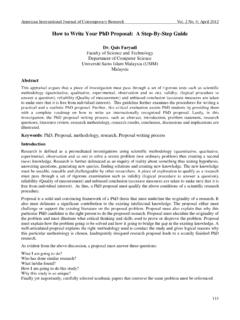Transcription of Template for Creating a Project Vision Statement
1 Template for Creating a Project Vision Statement An ESRI Technical Paper August 2004 ESRI 380 New York St., Redlands, CA 92373-8100, USA TEL 909-793-2853 FAX 909-793-5953 E-MAIL WEB Copyright 2004 ESRI All rights reserved. Printed in the United States of America. The information contained in this document is the exclusive property of ESRI. This work is protected under United States copyright law and other international copyright treaties and conventions. No part of this work may be reproduced or transmitted in any form or by any means, electronic or mechanical, including photocopying and recording, or by any information storage or retrieval system, except as expressly permitted in writing by ESRI. All requests should be sent to Attention: Contracts Manager, ESRI, 380 New York Street, Redlands, CA 92373-8100, USA.
2 The information contained in this document is subject to change without notice. GOVERNMENT RESTRICTED/LIMITED RIGHTS Any software, documentation, and/or data delivered hereunder is subject to the terms of the License Agreement. In no event shall the Government acquire greater than RESTRICTED/LIMITED RIGHTS. At a minimum, use, duplication, or disclosure by the Government is subject to restrictions as set forth in FAR Alternates I, II, and III (JUN 1987); FAR (JUN 1987) and/or FAR (Commercial Technical Data/Computer Software); and DFARS (NOV 1995) (Technical Data) and/or DFARS (Computer Software), as applicable. Contractor/Manufacturer is ESRI, 380 New York Street, Redlands, CA 92373-8100, USA. ESRI, the ESRI globe logo, , and are trademarks, registered trademarks, or service marks of ESRI in the United States, the European Community, or certain other jurisdictions.
3 Other companies and products mentioned herein are trademarks or registered trademarks of their respective trademark owners. J-9305 ESRI Technical Paper i Template for Creating a Project Vision Statement An ESRI Technical Paper Contents Page High-Level Project Overview .. 1 Business 1 problem Statement .. 1 Project Position .. 1 Organizational 2 User Description .. 2 User 2 User Environment .. 2 Current User 2 Alternative Solutions .. 3 Alternate Solution 1 .. 3 Alternate Solution 2 .. 3 Application Overview .. 3 Application Perspective .. 3 Summary of Application 3 Assumptions and Dependencies .. 3 Application Features.
4 4 Feature 4 Feature 4 Additional Application Requirements .. 4 Constraints .. 4 Quality 4 Precedence and Priority .. 4 Application Standards .. 4 Template for Creating a Project Vision Statement J-9305 August 2004 ii Contents ..Page System 5 Performance Requirements .. 5 Documentation 5 J-9305 ESRI Technical Paper _____ Template for Creating a Project Vision Statement The purpose of this document is to capture the client's overall Vision for the This information will help ensure that the Project goals and high-level requirements are well understood. The information provided in this document is often required prior to completing a detailed Project proposal or implementation plan. Please provide all information to the best of your ability, omitting only those sections that may be irrelevant to your Project or the current scope of work.
5 If you have an existing document that addresses the same issues, please feel free to attach it in its entirety or reference it as appropriate. High-Level Project Overview Business problem This section describes the business requirements being met by this Project . problem Statement This section summarizes the problem being solved by this Project . The following issues should be addressed: Describe the problem . Describe the stakeholders affected by the problem . Describe the impact of the problem on the organization. Describe what a successful solution would mean ( , what are the key benefits this Project will provide to the organization). Project Position This section summarizes at a high level the unique needs the Project intends to fill in your organization. Describe alternatives to the proposed solution, and state why the proposed solution is best suited for meeting your organization's needs.
6 A Project position Statement communicates the intended use of the application and the importance of the Project to all affected users. 1 This document has been adapted from the Rational Unified Process but has been tailored to a GIS Project life cycle perspective. For more information on the Rational Unified Process, please refer to Template for Creating a Project Vision Statement J-9305 August 2004 2 Organizational Position Summarize key issues that motivate your organization's technology decisions. Describe the organizational hierarchy as it relates to this Project ( , how will your department meet the needs of other users/departments in the organization). Describe how this Project will promote your department's mission. Some key questions include What is your organization's reputation?
7 What would you like it to be? How will this Project support your goals? User Description This section should profile the target users of the application. This section should not be used to state specific requirements but should provide context for why the requirements are needed. User Profiles Describe each unique type of user of the system. User types can be as divergent as super users and novice. For example, a geographic information system (GIS) super user might need a sophisticated, flexible tool for editing GIS data, while a novice user might need a user-friendly tool for querying map features. A thorough profile should cover the following topics for each type of user: Technical background and degree of sophistication Key job responsibilities Deliverables the user produces and for whom Problems that interfere with success How the target user defines success and how the user is rewarded User Environment Describe the working environment of the target user as it relates to this Project .
8 Following are some suggestions: Number of people involved in completing the typical tasks? Will this change? How long is a task cycle? Amount of time spent in each activity? Will this change? Any unique environmental constraints: mobile, outdoors, slow modem connection, and so forth? Which systems platforms are in use today? Future platforms? What other applications are in use with which this application might need to integrate? Current User Needs List the key problems with existing solutions as perceived by the user. Clarify the following issues for each problem : What is the nature of the problem ? What are the reasons for this problem ? How is it solved now? Template for Creating a Project Vision Statement J-9305 ESRI Technical Paper 3 What solutions does the user want?
9 Describe the relative importance the user places on the problem . Is it a problem that must be solved or an issue the user would simply like addressed? Alternative Solutions Identify alternatives the user perceives as feasible. Solutions might include buying a competitor's product, building a homegrown solution, or simply maintaining the status quo. List any known competitive choices that exist or may become available. Include the major strengths and weaknesses of each competitor as perceived by the end user. Alternate Solution 1 Alternate Solution 2 Application Overview This section provides a high-level view of the application capabilities, interfaces to other applications, and systems configurations. Application Perspective This section of the document should put the application in perspective to other related products and the user's environment.
10 If the application is independent and totally self-contained, state it here. If the application is a component of a larger system, then this subsection should relate how these systems interact and should identify the relevant interfaces between the systems. A diagram can be provided to describe the system and its interactions. Summary of Application Capabilities Summarize the major benefits and features the application should provide. Organize the functions so the list is understandable to the customer or to anyone else reading the document for the first time. A simple table listing the application function, its key benefits, and supporting features might suffice. For example: Internet Mapping System Application Function Key Benefit Provide Internet map view and query capabilities to department personnel.
